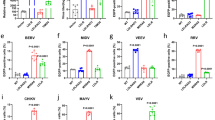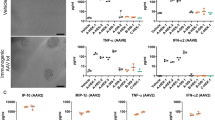Abstract
Sindbis virus can infect a broad range of insect and vertebrate cell types due to the widespread distribution of the cellular receptor for the virus. The development of Sindbis virus vectors that target specific cell types could have important implications for the design of gene therapy strategies. To achieve this goal we Have designed and constructed Sindbis virus particles displaying the IgG-binding domain of protein A. The protein A-envelope chimeric Sindbis virus vector has minimal infectivities against baby hamster kidney and human cell lines. When used in conjunction with monoclonal antibodies that react with cell-surface antigens, however, the protein A-envelope chimeric virus was able to infect human cell lines with high efficiency. Infection rates were 90% or higher for human lymphoblastoid cells. A variety of cells could be targeted by changing the monoclonal antibody without generating a new recombinant virus.
This is a preview of subscription content, access via your institution
Access options
Subscribe to this journal
Receive 12 print issues and online access
$209.00 per year
only $17.42 per issue
Buy this article
- Purchase on Springer Link
- Instant access to full article PDF
Prices may be subject to local taxes which are calculated during checkout
Similar content being viewed by others
References
Strauss, J.H. and Strauss, E.G. 1994. The alphaviruses: gene expression, replication, and evolution. Microbiol. Rev. 58: 491–562.
Liljeström, P. and Garoff, H. 1991. A new generation of animal cell expression vectors based on the Semliki Forest virus replicon. Biotechnology 9: 1356–1361.
Bredenbeek, P. and Rice, C.M. 1992. Animal RNA virus expression systems. Semin. Virol. 3: 297–310.
Xiong, C., Levis, R., Shen, P., Schlesinger, S., Rice, C.M., and Huang, H.V. 1989. Sindbis virus: an efficient, broad host'range vector for gene expression in animal cells. Science 243: 1188–1191.
Wang, K.-S., Kuhn, R.J., Strauss, E.G., Ou, S., and Strauss, J.H. 1992. High-affinity laminin receptor is a receptor for Sindbis virus in mammalian cells. J. Virol. 66: 4992–5001.
Stanley, J., Cooper, S.J., and Griffin, D.E. 1985. Alphavirus neurovirutence: monoclonal antibodies discriminating wild-type from neuroadapted Sindbis virus. J. Virol. 56: 110–119.
Olmsted, R.A., Meyer, W.J., and Johnston, R.E. 1986. Characterization of Sindbis virus epitopes important for penetration in cell culture and pathogenesis in animals. Virology 148: 245–254.
Polo, J.M., Davis, N.L., Rice, C.M., Huang, H.V., and Johnston, R.E. 1988. Molecular analysis of Sindbis virus pathogenesis in neonatal mice by using virus recombinants constructed in vitro. J. Virol. 62: 2124–2133.
Lustig, S., Jackson, A.C., Hahn, C.S., Griffin, D.E., Strauss, E.G., and Strauss, J.H. 1988. Molecular basis of Sindbis virus neurovirulence in mice. J. Virol. 62: 2329–2336.
Dubuisson, J. and Rice, C.M. 1993. Sindbis virus attachment: isolation and characterization of mutants with impaired binding to vertebrate cells. J. Virol. 67: 3363–3374.
Russell, S.J., Hawkins, R.E., and Winter, G. 1993. Retroviral vectors displaying functional antibody fragments. Nucleic Acids Res. 21: 1081–1085.
Somia, N.V., Zoppé, M., and Verma, I.M. 1995. Generation of targeted retroviral vectors by using single-chain variable fragment: An approach to in vivo gene delivery. Proc. Natl. Acad. Sci. USA 92: 7570–7574.
Marin, M., Noël, D., Valsesia-Wittman, S., Brockly, F., Etienne-Julan, M., Russel, S., et al. 1996. Targeted infection of human cells via major histocompatibility complex class I molecules by moloney murine leukemia virus-derived viruses displaying single-chain antibody fragment-envelope fusion proteins. J. Virol. 70: 2957–2962.
Kasahara, N., Dozy, A.M., and Kan, Y.W. 1994. Tissue-specific targeting of retro-viral vectors through ligand-receptor interactions. Science 266: 1373–1376.
Surolia, A., Pain, D., and Khan, M.I. 1982. Protein A: nature's universal anti-antibody. Trends Biochem. Sci. 7: 74–76.
Bredenbeek, P.J., Frolov, I., Rice, C.M., and Schlesinger, S. 1993. Sindbis virus expression vectors: packaging of RNA replicons by using defective helper RNAs. J. Virol. 67: 6439–6446.
Nilsson, B., Moks, T., Jansson, B., Abrahmsén, L., Elmblad, A., Holmgren, E., et al. 1987. A synthetic IgG-binding domain based on staphylccoccal protein A. Protein Erg. 1: 107–113.
Douglas, J.T., Rogers, B.E., Rosenfeld, M.E., Michael, S.I., and Curiel, M.F.D.T. 1996. Targeted gene delivery by tropism-modified adenoviral vectors. Nature Biotechnology 14: 1574–1578.
Rosenfeld, M.A., Siegfried, W., Yoshimura, D., Yoneyama, K., Fukayama, M., Stier, L.E., et al. 1991. Adenovirus-mediated transfer of a recombinant anti-antitrypsin gene to the lung epithelium in vivo. Science 252: 431–434.
Levine, B., Huang, Q., Isaacs, J.T., Reed, J.C., Griffin, D.E., and Hardwick, J.M. 1993. Conversion of lytic to persistent alphavirus infection by the bcl-2 cellular oncogene. Nature 361: 739–742.
Levine, B. and Griffin, D.E. 1992. Persistence of viral RNA in mouse brains after recovery from acute alphavirus encephalitis. J. Virol. 66: 6429–6435.
Wang, K.S., Schmaljohn, A.L., Kuhn, R.J., and Strauss, J.H. 1991. Antiidiotypic antibodies as probes for the Sindbis virus receptor. Virology 181: 694–702.
Ubol, S. and Griffin, D.E. 1991. Identification of a putative alphavirus receptor on mouse neural cells. J. Virol. 65: 6913–6921.
Löwenadler, B., Jansson, B., Paleus, S., Holmgren, E., Nilsson, B., Moks, T., et al. 1987. A gene fusion system for generating antibodies against short peptides. Gene 58: 87–97.
Fiering, S.N., Roederer, M., Nolan, G.P., Micklem, D.R., Parks, D.R., and Herzenberg, L.A., 1991. Improved FACS-Gal: Flow cytometric analysis and sorting of viable eukaryotic cells expressing reporter gene construction. Cytometry 12: 291–301.
Author information
Authors and Affiliations
Rights and permissions
About this article
Cite this article
Ohno, K., Sawai, K., lijima, Y. et al. Cell-specific targeting of Sindbis virus vectors displaying IgG-binding domains of protein A. Nat Biotechnol 15, 763–767 (1997). https://doi.org/10.1038/nbt0897-763
Received:
Accepted:
Issue Date:
DOI: https://doi.org/10.1038/nbt0897-763
This article is cited by
-
Roles of phosphatidylserine exposed on the viral envelope and cell membrane in HIV-1 replication
Cell Communication and Signaling (2019)
-
Separate Gene Transfers into Pre- and Postsynaptic Neocortical Neurons Connected by mGluR5-Containing Synapses
Journal of Molecular Neuroscience (2019)
-
In vivo gene transfer targeting in pancreatic adenocarcinoma with cell surface antigens
Molecular Cancer (2012)
-
Specific antibody-receptor interactions trigger InlAB-independent uptake of listeria monocytogenes into tumor cell lines
BMC Microbiology (2011)
-
Multiple Functions of the 37/67-kd Laminin Receptor Make It a Suitable Target for Novel Cancer Gene Therapy
Molecular Therapy (2010)



